|
Sportscar racing became very popular in the US after WWII. So popular, that in 1966 the Sports Car Club of America (SCCA) along with the Canadian Automobile Sports Club (CASC), founded the Canadian American Challenge Cup series for Group 7 type sports racers. When Johnson Wax became the title sponsor of the Can-Am, as it was usually called, it became the best paying racing series in the world. And though a North American series, the money meant that the cream of international auto racing were very interested in the Can-Am. Past and future F1 World Champions Phil Hill, Jack Brabham, John Surtees, Graham Hill, Denny Hulme, Jackie Stewart, Jody Scheckter, and Mario Andretti all participated in the Can-Am at one time or another. Indy 500 winners A.J. Foyt, Mark Donohue, and Parnelli Jones were also drawn to the series.
Along with the world's best drivers came the world's best auto manufacturers. Ford, Chevrolet, Porsche, and Ferrari, along with race car manufacturers Lola, McLaren, Chaparral, Shadow, BRM, March, and others all wanted to show what they were made of.
The Can-Am pushed the limits of engineering. Advances were made in aerodynamics, turbocharging, and the use of materials such as fiberglass, aluminum, and titanium. The cars were as fast or faster than the era's F1 cars.
Can-Am cars were classified as Group 7 racers by the International Motorsport Federation (FIA). Group 7 racers had very few restrictions placed on them. (Restrictions were added over the years, but it was pretty much an "open" formula.) No maximum engine size or turbocharger boost limits. No minimum weight. No tire limitations. No structure or material limitations. The cars did have to be open-cockpit, closed-bodied cars with two seats and two doors.
1966
The car to have that first season in 1966 was the Lola T70. John Surtees took the championship driving one, winning 3 of 6 races.
|
Mark Donohue and Dan Gurney each took a win driving T70s. Although Surtees' and Donohue's Lolas used Chevrolet V8s, Gurney's had a Ford. This would be Ford's only Can-Am victory. The Chevy V8s were the engine to have and would win every remaining race until Porsche came along in the '70s.
|
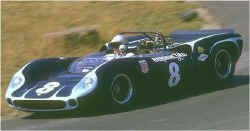
|
|
Jerry Grants Lola T70
|
The stars of the series, however, were the Chaparrals of Jim Hall and Phil Hill. The Chaparrals were the first cars to successfully mount upside down wings on tall struts in the back of the cars. Through the use of a foot pedal, these wings were held horizontal on the straights for low drag but then tilted downward in the corners to generate downforce to help hold the car to the track. Amazingly, as closely linked to the Can-Am as Chaparral is, the team only ever won one race in the series. That came when Hill won at Laguna Seca in this first season.
|
1967
The 1967 season began with Denny Hulme taking the first three races in a McLaren M6A. His teammate and team owner, Bruce McLaren, would win the next two and the championship. Reigning champion Surtees managed only one win in his T70, the season finale at Las Vegas.
|
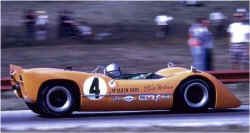
|
|
Bruce Mclaren's M6A
|
|
1968
1968 saw every race won by a McLaren. Three were won by Hulme and one by McLaren in Team McLaren M8As. Mark Donohue won at Bridgehampton in a customer M6B (McLaren built cars for privateers, but they always kept the latest and greatest goodies for themselves) and John Cannon at Laguna Seca in an ex-works M1B. Hulme would be this year's champion. Ferrari made their first foray into the Can-Am with the Chris Amon piloted 612P.
|


|
|
The Dominating Mclaren M8A of Bruce and Denny
|
|
1969
The 1969 season became the year of the Orange Elephants, as the Team McLaren cars were called. The "Bruce and Denny Show" won all 11 races, with Bruce taking six and his second championship. Their weapon this season was the M8B, McLaren's first car to carry a high-mounted wing in the rear.
|
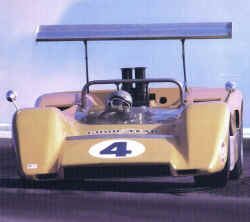
|
|
The 1969 M8B
|
|
Amazingly, Chaparral did away with a wing on their car, the 2H. Looking like a great white whale, the car, now driven by Surtees, did not do well. It even sprouted a huge centrally located wing late in the year, but it didn't help. The team had so many problems with the 2H that they sometimes fielded a bewinged McLaren M12 for Surtees.
|
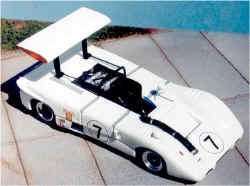
|
|
The Surtees M12 before the wing was added
|
|
1970
For 1970, because of wing strut failures during the 1969 F1 season, the FIA banned high-mounted wings, although those closer to the body were still allowed. McLaren's M8D would have its wing mounted between bodywork extentions at the rear that caused it to be nicknamed the "Batmobile". However, just before the start of the season, tragedy struck. Bruce McLaren was killed while testing an M8D in England.
|
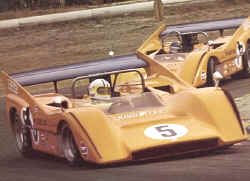
|
|
The M8D of Champion Hulme
|
Dan Gurney was hired to partner with Hulme and won the season opener at Mosport after a thrilling late race duel with Jackie Oliver in the Autocoast Ti-22.
The Ti-22 was the first car to use substantial amounts of titanium. It showed great promise but was destroyed in a crash during the second race of the season at St. Jovite, also won by Gurney. Oliver was unhurt, but he and the Autocoast team would not return until the final two races of the season, where it would finish second both times.
McLaren's only other competition came from the most unexpected place at the time -- Porsche. Watkins Glen held their Can-Am the day after their World Championship of Makes race, so the Group 5 sportscar from Saturday were allowed to race in the Can-Am on Sunday. Jo Siffert in a Wyer-Gulf Porsche 917 would finish second to Hulme. Then at Road Atlanta, Tony Dean's little 3-liter Porsche 908 would outlast all the big guns to win Porsche's first Can-Am race.
Gurney was forced to leave Team McLaren after three races because of sponsor conflicts and was replaced by Peter Gethin who would win one race. Hulme would win the remaining six and his second title.
The final Can-Am Chaparral appeared in 1970, the 2J "Sucker Car". It looked like a white brick and had a snowmobile engine mounted in the rear to power two fans used to suck the car down onto the track. Driven by first Jackie Stewart and then Vic Elford, it was fast, but it was also unreliable. At the end of the season, the "vacuum cleaner" system was banned, and Jim Hall left the Can-Am.
The models
The USA was the home of Big Banger sportscar racing with initially the home bred machines like Ol Yaller mixing it with the larger engined European Maserati and Ferrari sports cars. Gradually the cars became more sophisticated with the arrival of the Lotus 19 and Cooper Monaco. These cars got bigger engines; the Monaco became the King Cobra and Roger Penske built his Zerex from a Formula one Cooper. This was to become the starting point of the Mclaren sportscar dynasty as the "Jolly Green Giant" Ol Yaller, Arciero Ferrari 375MM driven by Dan Gurney and the Zerex are available from Marsh. A Cooper King Cobra can be had from K&R and MA scale models. The M1A Mclarens from Marsh and The Lotus 30 and 40 (the 30 with ten more problems) from SMTS, the MKI Chaparrals and Scarabs from Illustra and the Chaparral 2A and 2C from ESDO as a lead in to the true
Can Am cars.
Can Am models from this 1966 to 1970 are produced in the main by Marsh, ESDO, Illustra, Kaiser and MA Scale Models. For a period of the late 50's to 1974 it is one of the best covered areas of motor racing with many more models planned in the future.
A very small selection of available models from this early period are shown below. We will cover the final four years of the proper Can Am in a later issue.
|